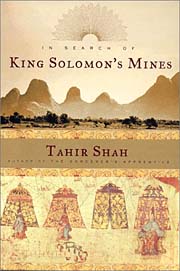|
|||
 |
|
Editorial
|
Press Releases
|
Book Reviews
|
Fragments
In Search of King Solomon's Minesby Tahir Shah
Author: Tahir Shah Type: Travelogue Edition: 2002 hardcover edition Reviewed by: Doug Elwell Rating:     
Though the majority of the book is set in Ethiopia, Shah started his quest for the fabled gold of Solomon in Jerusalem, in a small tourist shop. Spotting a small, crudely executed map hung prominently behind the shopkeeper, Tahir inquired as to its provenance. The shopkeeper, who had the dubious name of "Ali Baba", answered that it was an ancient map to the fabled gold mines of Solomon, or "Suleiman" in Arabic. After swearing on the graves of his ancestors that he would never sell the map to anyone outside of his family, after some sweet tea and skilled haggling on the part of Tahir, the map was soon in his possession, and the quest had officially begun. One of the delights of Shah's writing style is the clever, pithy way he starts some chapters, a method which immediately puts one "in the moment". The first sentence of chapter two, for example, which describes his arrival in Addis Ababa, the capitol of Ethiopia, begins with the statement, "When the blind Mauritanian woman's deranged guide-dog sank its front teeth into my thigh...." From there on in, his experiences in Ethiopia seem to go from bad to worse, albeit punctuated with the occasional realization that Ethiopia, despite its problems, is a truly beautiful country. In Addis Ababa, Shah met up with an amicable cab driver named Samson. Samson proved to be a godsend to Shah, both figuratively and literally — figuratively in that his knowledge of the language and cultures of the region made the trip much easier, and literally because he was an evangelical Christian, carrying a massive Bible around with him at all times and preaching the Gospel wherever he went. The Bible also proved useful as a reference book, as Ethiopia is a land steeped in Christian tradition. Not only is it believed to be the fabled land of Ophir, mentioned in the Bible as the location of Solomon's gold mines, but it is also the location of numerous ancient churches, the location of a formerly lost group of Ethiopian Jews known as the falashas, and may even be the last resting place of the Ark of the Covenant. Perhaps the most interesting parts of In Search of King Solomon's Mines are when Shah sets their journey in the context of the ancient history and legends of the region. Their first stop, a visit to Harar in far eastern Ethiopia, was said to be guarded by vicious hyenas and "Solomons's army of Jinn", powerful evil spirits that Solomon had enslaved for use in mining the 666 talents of gold that he took as tribute from the mines each year. In actuality, however, the only dangers that Tahir and Samson met in the cave that the locals had identified as the location of the mine were the hordes of bats and the fumes of the burning rubber boot that their guide had used to light their way. Shah handles these moments, when the sublime meets the ridiculous, with a sensitivity and insight that is refreshing to read. Their second stop in the search for King Solomon's Mines was Bedakaysa, in far southern Ethiopia. Another of Shah's endearing methods for transporting the reader into his travel experience in Ethiopia is his frank discussion of how awful the transporation is. The buses are literally packed with people, to the point where there is little or no space separating everyone. They also frequently break down, a stop every few miles to change a blown tire or other part being a common occurrence. Moreover, there are few paved roads. Most roads are merely well-worn ruts that turn to thick, gray mud in the rains which can come suddenly, without warning. All these issues were true of the trip south to Bedakaysa, which was probably the roughest and most dangerous town that Shah visited. An illegal gold mine worked informally by locals, Bedakaysa was described by Samson, a former miner, as "hell on earth". Samson recalled his former life as a gold miner, before his conversion to Christianity, as one filled with drunkenness and debauchery. The lust for gold had turned him and his friends into animals, enslaved to their own selfish desires. Though Sampson had escaped that self-destructive lifestyle, hundreds of others still eked out a living searching for the precious metal in the open-air mine of Bedakaysa, spending it all on wine, women and song. Determining that Bedakaysa also did not fit the profile of King Solomon's Mines, Tahir and Samson went back to Addis Ababa to make plans to explore their remaining options. There they met a Somalian driver by the name of Bahru who had a jeep for rent. He claimed the jeep had once been used by Haile Selassie, the former king of Ethiopia. However, though now it was old and falling apart, bald tires and all, it was the best Tahir and Samson could find, so they took it. Bahru then took them on the northern leg of their trek, up through Lalibela with its ancient, beautiful rock-cut churches, all the way to Axum, where some believe the Ark of the Covenant is kept. While in Lalibela, Shah took the time to view what the local priests billed as "the gold of Sheba", which turned out to be only some golden crosses — ancient and beautiful, but not what they were looking for. Axum was similarly unfruitful, and even a stop in the relatively modern city of Mekele, with its nearby gold deposits, yielded no answers. Down to his last option, Shah headed for the forbidding mountain of Tullu Wallel, in western Ethiopia. Abandoned by Bahru, who claimed his luck — which had brought them through many tight spots — had run out, Shah and Samson were forced to use mules for the last part of the journey. Warned by local villagers that the mountain was haunted not by a devil, but by the devil, they ignored their advice and pressed on. The locals still believed, however, and it became very difficult to find people to help them make the journey up the mountain. Shah then claimed that they were missionaries, sent to throw the devil back into hell, a ruse which convinced enough people to make the journey. Though they finally managed to get a few diehards to make the journey, the curse made itself known in the form of heavy rains and nearly impassable terrain, making them question whether or not the devil truly was guarding King Solomon's Mines.
In Search of King Solomon's Mines is one of those rare travel books that it is difficult to put down. Well written, the story and the characters are brought to life by Shah's elegant prose. And even though this review will give you a good overview of what happens in the book, by far the most interesting parts of the book are the details of not where they visited, but of the journey itself and of the people who made it. I highly recommend this well-written, beautifully designed book for those interested in travel, or for those who just like a cracking good read.
Add it to your library today.
Editorial
|
Press Releases
|
Book Reviews
|
Fragments
|





 very once in a while one comes upon a golden treasure of a travel book — a book which, besides being full of useful information and travel advice, surprises you both with its wit and with its insight into the human condition. Tahir Shah's
very once in a while one comes upon a golden treasure of a travel book — a book which, besides being full of useful information and travel advice, surprises you both with its wit and with its insight into the human condition. Tahir Shah's


 In Search of King Solomon's Mines
In Search of King Solomon's Mines The Sign and the Seal: The Quest for the Lost Ark of the Covenant
The Sign and the Seal: The Quest for the Lost Ark of the Covenant King Solomon's Mines (Oxford World's Classics)
King Solomon's Mines (Oxford World's Classics) A Modern Translation of the Kebra Nagast: (The Glory of Kings)
A Modern Translation of the Kebra Nagast: (The Glory of Kings) The Flower of Sheba
The Flower of Sheba 